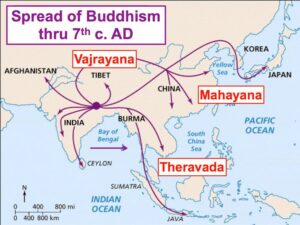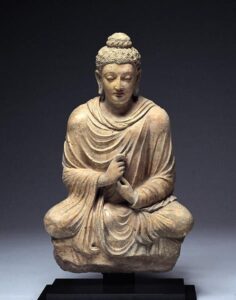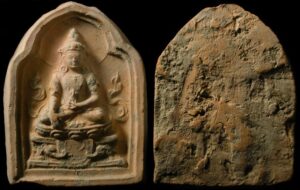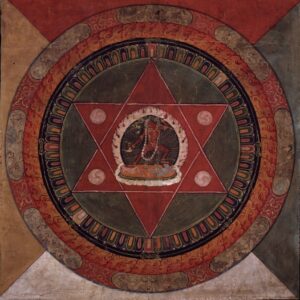A Short History of the Buddhist Schools
A Short History of the Buddhist Schools
The distinctive Buddhist ways of thinking, actually working in the current day, created after the demise of the Buddha (l. c. 563 – c. 483 BCE) with an end goal to propagate his lessons and honor his model. Despite the fact that Buddha himself is said to have mentioned that, following his demise, no pioneer was to be picked to lead anything like a school, this was disregarded and his devotees appear to have decently fast systematized Buddhist ideas with rules, guidelines, and pecking order.

From the start, there may have been a brought together vision of what Buddha had educated yet, on schedule, conflicts over what comprised the “genuine instructing” brought about fracture and the foundation of three fundamental schools:
- Theravada Buddhism (The School of the Elders)
- Mahayana Buddhism (The Great Vehicle)
- Vajrayana Buddhism (The Way of the Diamond)
Theravada Buddhism is considered the most seasoned and claims to keep up Buddha’s unique vision and lessons. Mahayana Buddhism is told that have separated from Theravada in the conviction that it was too narcissistic and had lost the genuine vision; this school likewise asserts it holds to the Buddha’s unique educating. As a matter of fact, nonetheless, the two schools may have been set up around a similar time, just with the various center, and most likely rose up out of two prior schools: the Sthaviravada (conceivable antecedent to Theravada) and the Mahasanghika (likewise given as Mahasamghika, considered by some the previous Mahayana). The association between these previous schools and the later ones, notwithstanding, has been tested. Vajrayana Buddhism grew, generally in Tibet, because of what was seen as such a large number of rules in Mahayana Buddhism and accentuated living the Buddhist walk normally regardless of thoughts of what one was “assumed” to do thus it, too, cases to ever be the most valid.
ALL BUDDHIST SCHOOLS MAINTAIN A BELIEF IN THE FOUR NOBLE TRUTHS and EIGHTFOLD PATH AS PREACHED BY THE BUDDHA BUT DIFFER IN HOW THEY CHOOSE TO FOLLOW THAT PATH.
Each of the three schools keeps faith in the Four Noble Truths and Eightfold Path as lectured by the Buddha yet contrasts – now and then all together – by the way they decide to follow that way. Equitably, none are viewed as any more genuine than the others, nor are the numerous minor schools which have created, in spite of the fact that disciples of each accept in any case. Despite the fact that Buddhism is regularly seen by non-disciples as a uniform conviction framework, it is just about as shifted as some other practically speaking at the same time, hypothetically, in any event, an advanced common Buddhist can partake in ceremonies with a strict Buddhist without concern or struggle and all work toward similar fundamental objectives.
History of the Buddhist Schools
Buddha and Buddhism
As per the central record of Buddha’s life, he has conceived Siddhartha Gautama, a Hindu sovereign, and his dad, expecting to keep him from following an otherworldly way as opposed to succeeding him as ruler, kept him from any encounters which may have made him mindful of anguish and passing. The lord’s arrangement prevailing for a very long time until Siddhartha saw the celebrated Four Signs while out riding one day – a matured man, a wiped out man, a dead man, and an otherworldly plain – and got mindful of the truth of disorder, mature age, and demise.
He denied his riches and position and followed the case of the otherworldly parsimonious, ultimately accomplishing edification after perceiving the intrinsic fleetingness of all parts of everyday routine and acknowledging how one could experience without anguish. He fostered the idea of the Four Noble Truths, which express that enduring in life is brought about my connection to the things of life, and the Eightfold Path, the otherworldly control one ought to follow to accomplish discharge from connection and the torment of wanting and misfortune. Researcher John M. Koller remarks:
The Buddha’s instructing of [the Four Noble Truths] depended on his knowledge into associated emerging (pratitya samutpada) like the idea of presence. Related emerging implies that everything is continually changing, that nothing is perpetual. It additionally implies that all presence is sacrificial, that nothing exists independently, without anyone else. Also, past the temporariness and magnanimity of presence, associated emerging implies that whatever emerges or stops does so subject to conditions. This is the reason understanding the conditions that lead to [suffering] is significant to the way toward dispensing with [suffering]. (64)
Buddha outlined these conditions through the Wheel of Becoming which has in its center point the ternion of obliviousness, wanting, and repugnance, between the center point and edge the six sorts of enduring presence, and on the edge the conditions which lead to dukkha (interpreted as “languishing“). The obliviousness of the real essence of life empowers longing for those things one accepts are attractive and abhorrence for things one feeling of dread and rejects. Gotten on this wheel, the spirit is dazed to the real essence of life thus sentences itself to samsara, the interminable redundancy of resurrection and passing.

Spread and Fragmentation
Buddha lectured his vision from the hour of his edification until his demise at 80 years old, so, all things considered, he mentioned that his supporters ought not to pick a pioneer however that each should lead themselves. He additionally mentioned that his remaining parts be set in a stupa at a junction. Neither of these solicitations was respected as his devotees decently fast coordinated themselves collectively with a pioneer and split his remaining parts between themselves, each deciding to put them in a stupa in an area of their decision.
BUDDHIST SCHOOLS HAD TO CONTEND WITH THE WELL-ESTABLISHED BELIEF SYSTEMS and, IN AN EFFORT TO LEVEL THE PLAYING FIELD, DEVELOPED AN ILLUSTRIOUS FOUNDATION STORY.
Around 400 BCE, they held the First Council at which they set up acknowledged Buddhist regulation dependent on the Buddha’s lessons and, in 383 BCE, they held a Second Council at which, as indicated by the standard record of the gathering, the Sthaviravada school demanded the recognition of ten bans in the ascetic order which the greater part dismissed. Now, either the Sthaviravada school left the local area (known as the sangha) or the lion’s share separated themselves from the Sthaviravada and called themselves Mahasanghika (“Great Congregation”). Every one of the later schools at that point created from this first break.
These schools needed to fight with the more grounded conviction frameworks of Hinduism and Jainism and, with an end goal to even the odds, fostered a celebrated establishment story for their author and credited to him various supernatural occurrences. All things considered, Buddhism stayed a little organized in India, one among many, until it was advocated by the Mauryan ruler Ashoka the Great (r. 268-232 BCE) who accepted the confidence and started its spread. He sent teachers to different countries, for example, Sri Lanka, China, Korea, Thailand, and Buddhism was acknowledged in these spots definitely more rapidly than in its nation of origin.
Doctrinal contrasts, notwithstanding, prompted further divisions inside the local area of disciples. As the conviction framework turned out to be more standardized, these distinctions turned out to be more huge. Various standards of sacred writing created which were held by some as obvious while dismissed by others and various practices emerged in light of the sacred text. For instance, the Pali standard, which arose out of Sri Lanka, kept up that Buddha was an individual who, albeit supplied with incredible profound force, actually accomplished illumination through his own endeavors and, when he passed on, he was liberated from samsara and accomplished complete freedom from human issues.

As Buddhism spread, notwithstanding, the originator was idolized as an extraordinary being who had consistently existed and would consistently exist. Buddha’s demise was as yet perceived as his nirvana, a “smothering” of all connection and need, yet a few disciples no longer considered this to be just a getaway from samsara yet a height to a forever standing state; liberated from samsara, yet present in the soul. The Mahasanghika school held to this conviction just as numerous others, (for example, the case that the Buddha had never existed truly, just as a sort of blessed nebulous vision) which remained in direct differentiation to the Sthaviravada and, later, the Theravada schools. Albeit the focal vision of the Buddha was held by disciples, doctrinal contrasts like this one prompted the foundation of the various schools of Buddhist ideas.
Despite the fact that there were really numerous breaks before the foundation of Theravada, Mahayana, and Vajrayana (the Mahasanghika school alone created three distinct organizations by c. 283 BCE), the division of these schools from the first sangha is said to have been anticipated by the Buddha himself in what is known as The Three Turnings. This idea depends on that of the Dharmachakra (Wheel of eight spokes, a natural Buddhist image) which addresses the Eightfold Path, educated by dharma which, in Buddhism, is perceived as “inestimable law”. The Dharmachakra has consistently been moving and consistently will be, however, to the extent human acknowledgment of it goes, it was gotten rolling when Buddha gave his first message, would then make the primary turn with the foundation of Theravada Buddhism, a second with Mahayana, and a third with Vajrayana.
Theravada Buddhism
Theravada Buddhism is supposed to be the most seasoned type of conviction framework, yet this is tested by current researchers. Robert E. Buswell, Jr. what’s more, Donald S. Lopez, Jr. clarify:
Notwithstanding the manner by which researchers have depicted the practice, Theravada is neither inseparable from early Buddhism nor a more unblemished type of religion preceding the ascent of the Mahayana. Such a case proposes a condition of partisan latency that gives a false representation of the variety after some time of tenet and practice inside what comes to be known as the Theravada custom. (904)
All things considered, a large number of the individuals who self-distinguish as Theravada Buddhists do in any case make the case that it is the most established variant of Buddhism and the nearest to the author’s vision. It is known as the “Instructing of the Elders” which gets from a similar name held by the previous school of Sthaviravada, and this is now and again deciphered to imply that its originators were those nearest to the Buddha however, the term was ordinarily utilized in India to signify any ascetic faction, and this applies straightforwardly to Theravada.
Followers center around the Three Trainings (trisksa):
- Sila (moral lead)
- Samadhi (contemplation)
- Prajna (shrewdness)
This order is seen as a feature of the Eightfold Path and is propelled by the focal figure of the school, the sage Buddhaghosa (fifth century CE) whose name signifies “Voice of the Buddha” for his capacity to decipher and remark upon Buddhist precept. They hold the Pali group to be the most genuine and spotlight on a devout translation of the Buddhist way in which the individual looks to turn into an arhat (holy person) and has no commitment to show others the route toward illumination. One may unquestionably do as such in the event that one decides yet, in contrast to Mahayana Buddhism, the objective isn’t to turn into an otherworldly manual for other people however to liberate one’s self from samsara.

Theravada Buddhism is split between a church of priests and an assemblage of laypeople and it is perceived that the priests are more profoundly progressed than the normal people. Ladies are viewed as mediocre compared to men and are not considered competent in accomplishing illumination until they are resurrected as a male. The Theravada school is some of the time alluded to as Hinayana (“little vehicle”) by Mahayana Buddhists, however, it ought to be noticed that this is viewed as an affront by Theravada Buddhists in that it proposes their school isn’t just about as significant as Mahayana.
MAHAYANA IS THE MOST WIDESPREAD and POPULAR FORM OF BUDDHISM IN THE WORLD TODAY.
Mahayana Buddhism
Mahayana Buddhists named themselves the “Incomparable Vehicle” either in light of the fact that they believed they held the genuine lessons and could convey the vast majority to edification (as has been asserted) or in light of the fact that they created from the early “Incredible Congregation” Mahasanghika school and wished to separate themselves from it, anyway marginally. It was established 400 years after Buddha’s demise, presumably roused by the early Mahasanghika belief system, and was smoothed out and arranged by the sage Nagarjuna (c. second century CE), the focal figure of the school. It might have at first been a minor school prior to connecting with Mahasanghika or, as per a few researchers, created all alone without that school’s impact yet, in any case, Mahayana is the most far-reaching and famous type of Buddhism on the planet today, spreading from its underlying acknowledgment in China, Korea, Mongolia, Japan, Sri Lanka, and Tibet to focuses from one side of the planet to the other.
The Mahayana school accepts that all individuals have a Buddha nature and can achieve extraordinary mindfulness, turning into a Bodhisattva (“substance of illumination“), who would then be able to manage others in a similar way. Followers look to achieve the condition of sunyata – the acknowledgment that everything is without inherent presence, nature, and enduring importance – a getting free from the brain that empowers one to perceive the real essence of life. Having achieved this higher state, similarly as, one turns into a buddha. This supernatural state is like how divine beings and spirits were seen by the Buddha himself – as existing however unequipped for delivering any support of the individual – yet, as a Bodhisattva, the two ladies and men who have stirred can help other people to help themselves.

Likewise, with Theravada and each and every school of Buddhism, the emphasis is on oneself – self-flawlessness and self-reclamation – and no other can accomplish the otherworldly work which one necessity to do to deliver one’s self from misery. In spite of the fact that Buddha is here and there seen as an exalted being by Mahayana Buddhists, the principles don’t urge one to approach him for help. Following Buddha’s own vision, a faith in a maker god who is mindful of one’s petitions is debilitated on the grounds that it connects one to a force outside of one’s self and sets one up for disillusionment and dissatisfaction when supplications go unanswered.
It is not necessarily the case that no Mahayana Buddhists supplicate straightforwardly to the Buddha; the practice of addressing Buddha in sculpture and workmanship, of appealing to these articles, and thinking of them as sacred – saw in Mahayana Buddhism – was started by the Mahasanghika school and is among the many convincing motivations to accept the more youthful school arose out of the more established one.
Vajrayana Buddhism
Vajrayana Buddhism (“Diamond Vehicle”) is alleged in view of its relationship of edification with a tough substance. Its name is additionally given as “Thunderclap Vehicle“, particularly regarding Tantric or Zen Buddhism, in that illumination falls like a thunderclap after one has invested the necessary exertion at culminating oneself. It is frequently viewed as a branch of Mahayana Buddhism – is even referred to as an organization of that school – yet really gets principles from both Mahayana and Theravada Buddhism while adding its very own advancement.
In both Theravada and Mahayana Buddhism, one chooses to follow the way, acknowledges the Four Noble Truths and the Eightfold Path as authentic, and focuses on a profound control which will prompt illumination by repudiating unbeneficial propensities. In Vajrayana Buddhism, it is perceived that one as of now has a Buddha-nature – everybody does, similarly, as Mahayana accepts – yet, in Vajrayana, one just needs to understand this to completely stir. A follower, in this way, doesn’t need to surrender negative routines like drinking liquor or smoking immediately to start one’s work on the way; one just needs to focus on after the way and the craving to take part in unfortunate and harmful practices will consistently lose their appeal. Rather than separating one’s self from want, one stage toward and through it, shedding one’s connection as one continues in the discipline.


